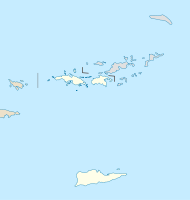
Photo from wikipedia
A highly frequented beach in Marseille, France, was monitored on an hourly basis during a summer day in July 2018, to determine possible water and sand fecal pollution, in parallel… Click to show full abstract
A highly frequented beach in Marseille, France, was monitored on an hourly basis during a summer day in July 2018, to determine possible water and sand fecal pollution, in parallel with influx of beach users from 8 a.m. to 8 p.m. Fecal indicator bacteria were enumerated, together with four host-associated fecal molecular markers selected to discriminate human, dog, horse, or gull/seagull origins of the contamination. The antimicrobial resistance of bacteria in water and sand was evaluated by quantifying (i) the class 1, 2, and 3 integron integrase genes intI, and (ii) blaTEM, blaCTX–M, and blaSHV genes encoding endemic beta-lactamase enzymes. The number of beach users entering and leaving per hour during the observation period was manually counted. Photographs of the beach and the bathing area were taken every hour and used to count the number of persons in the water and on the sand, using a photo-interpretation method. The number of beach users increased from early morning to a peak by mid-afternoon, totaling more than 1,800, a very large number of users for such a small beach (less than 1 ha). An increase in fecal contamination in the water corresponded to the increase in beach attendance and number of bathers, with maximum numbers observed in the mid-afternoon. The human-specific fecal molecular marker HF183 indicated the contamination was of human origin. In the water, the load of Intl2 and 3 genes was lower than Intl1 but these genes were detected only during peak attendance and highest fecal contamination. The dynamics of the genes encoding B-lactamases involved in B-lactams resistance notably was linked to beach attendance and human fecal contamination. Fecal indicator bacteria, integron integrase genes intI, and genes encoding B-lactamases were detected in the sand. This study shows that bathers and beach users can be significant contributors to contamination of seawater and beach sand with bacteria of fecal origin and with bacteria carrying integron-integrase genes and beta lactamase encoding genes. High influx of users to beaches is a significant factor to be considered in order to reduce contamination and manage public health risk.
Journal Title: Frontiers in Microbiology
Year Published: 2021
Link to full text (if available)
Share on Social Media: Sign Up to like & get
recommendations!